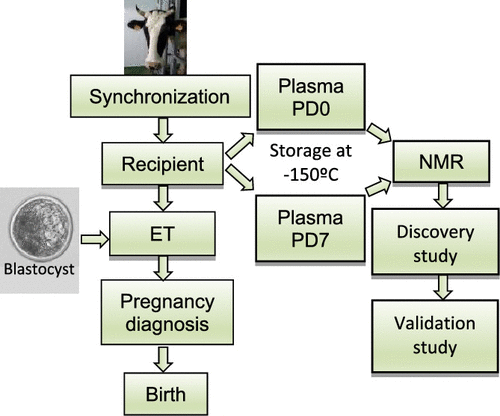当前位置:
X-MOL 学术
›
J. Proteome Res.
›
论文详情
Our official English website, www.x-mol.net, welcomes your
feedback! (Note: you will need to create a separate account there.)
Blood Plasma Metabolomics Predicts Pregnancy in Holstein Cattle Transferred with Fresh and Vitrified/Warmed Embryos Produced in Vitro.
Journal of Proteome Research ( IF 3.8 ) Pub Date : 2020-01-24 , DOI: 10.1021/acs.jproteome.9b00688 Enrique Gómez 1 , Pascal Salvetti 2 , Julie Gatien 2 , Susana Carrocera 1 , David Martín-González 1 , Marta Muñoz 1
Journal of Proteome Research ( IF 3.8 ) Pub Date : 2020-01-24 , DOI: 10.1021/acs.jproteome.9b00688 Enrique Gómez 1 , Pascal Salvetti 2 , Julie Gatien 2 , Susana Carrocera 1 , David Martín-González 1 , Marta Muñoz 1
Affiliation

|
Metabolomics may identify biomarkers in blood that differentiate pregnant from open embryo recipients. Fresh and vitrified/warmed, in vitro-produced embryos were transferred to Holstein recipients (discovery group). Recipient blood plasma collected on Day-0 (estrus) and Day-7 (before embryo transfer) were analyzed by nuclear magnetic resonance (N = 36 metabolites quantified). Metabolites whose concentrations differed between open and pregnant recipients were analyzed [(P < 0.05); false discovery rate (FDR) (P < 0.05)]. Biomarkers were identified in Day-7 plasma (receiver operator characteristic-area under curve (ROC-AUC) > 0.650; t-test P < 0.05; random forests, mean decrease accuracy) and cross-validated in independent Holstein, beef, and crossbred recipients (overall classification accuracy -OCA-; P < 0.05). Recipients with fresh embryos showed N = 6 biomarkers consistently on Day-40, Day-62, and at birth. Recipients with vitrified embryos showed N = 5 biomarkers on Day-40 and Day-62 but only one biomarker at birth. The most predictive biomarkers identified at birth within fresh embryos were oxoglutaric acid (ROC-AUC = 0.709; OCA = 0.812) and ornithine (ROC-AUC = 0.731; OCA = 0.727), while l-glycine was identified in vitrified embryos (ROC-AUC = 0.796; OCA = 0.667) together with other predictive biomarkers not identified at birth (Day-62: l-glutamine ROC-AUC = 0.757; OCA = 0.767) and l-lysine (Day-62: ROC-AUC = 0.680; OCA = 0.767). Pathway enrichment analysis distinguished between pregnant recipients for fresh (enriched energy oxidative metabolism from fat) and vitrified (lower lipid metabolism) embryos. Metabolomics can select individuals that will become pregnant in a defined cycle.
中文翻译:

血浆血浆药物代谢组学可预测移植有新鲜和玻璃化/暖化胚胎的荷斯坦牛的妊娠。
代谢组学可以鉴定血液中的生物标志物,从而将孕妇与开放胚胎接受者区分开。将新鲜和玻璃化/加热的体外产生的胚胎转移至荷斯坦受体(发现组)。在第0天(发情)和第7天(胚胎移植前)收集的收件人血浆通过核磁共振分析(定量N = 36种代谢物)。分析了开放和怀孕接受者之间浓度不同的代谢物[(P <0.05);错误发现率(FDR)(P <0.05)]。在第7天血浆中鉴定出生物标志物(受体操作者特征曲线下面积(ROC-AUC)> 0.650; t检验P <0.05;随机森林,平均降低准确度),并在独立的荷斯坦牛,牛肉和杂种中进行交叉验证接受者(总体分类准确度-OCA-; P <0.05)。带有新鲜胚胎的收件人在第40天,第62天和出生时始终显示N = 6个生物标记。带有玻璃化胚胎的收件人在第40天和第62天显示N = 5个生物标记,但出生时只有一个生物标记。在新鲜胚胎中出生时鉴定出的最具预测性的生物标志物是氧戊二酸(ROC-AUC = 0.709; OCA = 0.812)和鸟氨酸(ROC-AUC = 0.731; OCA = 0.727),而在玻璃化胚胎中鉴定出了L-甘氨酸(ROC- AUC = 0.796; OCA = 0.667)以及其他在出生时未发现的预测生物标记物(第62天:1-谷氨酰胺ROC-AUC = 0.757; OCA = 0.767)和l-赖氨酸(第62天:ROC-AUC = 0.680; OCA = 0.767)。途径富集分析将怀孕的受孕者分为新鲜(富含脂肪的能量氧化代谢)和玻璃化(较低的脂质代谢)胚胎。
更新日期:2020-02-06
中文翻译:

血浆血浆药物代谢组学可预测移植有新鲜和玻璃化/暖化胚胎的荷斯坦牛的妊娠。
代谢组学可以鉴定血液中的生物标志物,从而将孕妇与开放胚胎接受者区分开。将新鲜和玻璃化/加热的体外产生的胚胎转移至荷斯坦受体(发现组)。在第0天(发情)和第7天(胚胎移植前)收集的收件人血浆通过核磁共振分析(定量N = 36种代谢物)。分析了开放和怀孕接受者之间浓度不同的代谢物[(P <0.05);错误发现率(FDR)(P <0.05)]。在第7天血浆中鉴定出生物标志物(受体操作者特征曲线下面积(ROC-AUC)> 0.650; t检验P <0.05;随机森林,平均降低准确度),并在独立的荷斯坦牛,牛肉和杂种中进行交叉验证接受者(总体分类准确度-OCA-; P <0.05)。带有新鲜胚胎的收件人在第40天,第62天和出生时始终显示N = 6个生物标记。带有玻璃化胚胎的收件人在第40天和第62天显示N = 5个生物标记,但出生时只有一个生物标记。在新鲜胚胎中出生时鉴定出的最具预测性的生物标志物是氧戊二酸(ROC-AUC = 0.709; OCA = 0.812)和鸟氨酸(ROC-AUC = 0.731; OCA = 0.727),而在玻璃化胚胎中鉴定出了L-甘氨酸(ROC- AUC = 0.796; OCA = 0.667)以及其他在出生时未发现的预测生物标记物(第62天:1-谷氨酰胺ROC-AUC = 0.757; OCA = 0.767)和l-赖氨酸(第62天:ROC-AUC = 0.680; OCA = 0.767)。途径富集分析将怀孕的受孕者分为新鲜(富含脂肪的能量氧化代谢)和玻璃化(较低的脂质代谢)胚胎。











































 京公网安备 11010802027423号
京公网安备 11010802027423号